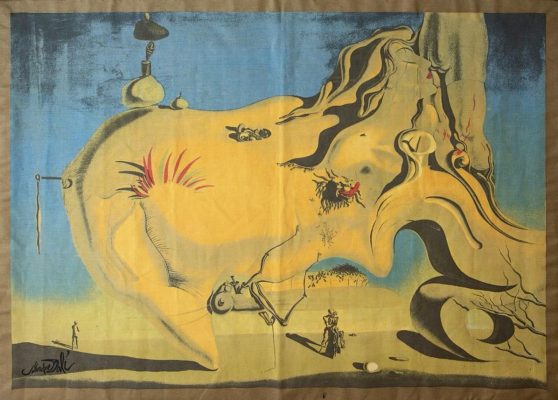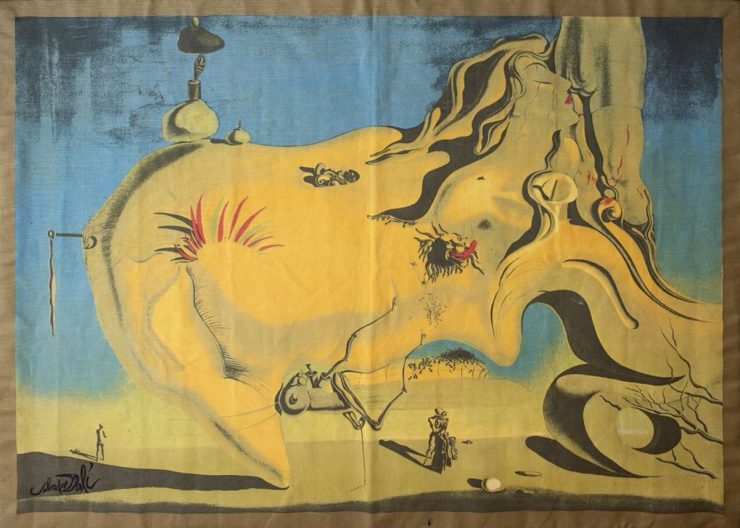25 January - 27 July 2025
At the Historical Infantry Museum in Rome, from January 25 to July 27, 2025, the exhibition “Salvador Dalí – Between Art and Myth”, curated by Vincenzo Sanfo, will take place. A journey into Dalí’s visions, featuring paintings, sculptures, engravings, and documents, showcasing the dreamlike dimension of Surrealism and the extraordinary personality of the genius Catalan artist.

Surrealism officially began in France in 1924 with the Surrealist Manifesto, written by André Breton. More than just an artistic movement, it was an avant-garde trend aimed at penetrating and revealing the hidden layers of consciousness. Surpassing reality, overturning it, and unveiling its deeper essence were the primary goals of this movement, which ideologically continued the iconoclastic intent of Dadaism, while reversing its destructive emphasis.
Surrealist artists explored dreams, irrationality, madness, and hallucinatory states, liberating human creativity from all logical constraints. In this context, they aligned with the then-revolutionary research of Sigmund Freud, finding in psychoanalysis the key to accessing the latent content of the mind. From this intellectual environment emerged works that blended ordinary images with blurred memories, producing startling associations that inspired constant wonder.
Salvador Dalí, born in Figueres in 1904, embodied the spirit of Surrealism with exceptional intensity, although he later formally distanced himself due to political disagreements with Breton’s group. With an eccentric personality and unparalleled talent, Dalí became a spokesperson for an avant-garde artistic language, capable of merging his nightmares with rigorous painting techniques.
His famous statement, “I am Surrealism”, made in response to his expulsion from the movement, asserted the independence of his poetic vision. His style, heavily influenced by movements such as Dadaism and Cubism, retained a strong surrealist foundation, populated by enigmatic figures, distorted objects, and recurring references to the dreamlike and subconscious. Dalí’s originality also shone through in his invention of the paranoiac-critical method, a conceptual process he used to translate unconscious distortions onto canvas.
Dalí’s famous “softness,” as seen in the melting clocks of his renowned The Persistence of Memory, exemplifies his paranoiac-critical approach. Essentially, the artist immerses himself in a self-induced state of paranoia—an inner journey through fears, hallucinations, and obsessions—which he then meticulously translates onto canvas. This practice, drawing from Freudian psychoanalysis, unveils hidden dimensions, transporting the viewer into a space where objects undergo metamorphoses and logic appears to stretch and bend.
In Dalí’s paintings, time is revealed as relative, as suggested by the image of the melting clocks, and nature transforms into hybrid and symbolic creatures, like the elephants with long, slender legs, often burdened with obelisks that create a delicate contrast between heaviness and lightness.
One of the reasons for Dalí’s break with the Surrealists was his reluctance to link painting to political matters. While Breton and other group members adopted clear ideological stances, Dalí chose to retreat into his private sphere, focusing on the dreamlike realm and the boundless potential of imagination. This refusal to take a position aligns with his belief that art should express the unconscious, free from external influences such as politics, morality, or even rationality.
Despite his expulsion, Dalí was invited to participate in several Surrealist exhibitions, further proof of the allure and value of his work, which managed to embody, even in a dissident form, the most authentic spirit of the movement. After the war, his artistic vision evolved again into what is known as nuclear mysticism, where he combined religious and scientific themes inspired by Albert Einstein’s discoveries and the historical events of Hiroshima and Nagasaki.
The exhibition “Salvador Dalí – Between Art and Myth”, open at the Historical Infantry Museum of Rome from January 25 to July 27, 2025, features approximately 200 works from private French and Italian collections. This significant collection recounts Dalí’s entire creative journey, from his early paintings and drawings to the boldest dreamlike and religious experiments of his mature period. The exhibit also includes lithographs, ceramics, sculptures, glass objects, engravings, and valuable documents, such as books and photographs.
This variety highlights the artist’s eclecticism and his relentless curiosity for diverse materials and media. The exhibition aims to engage both Surrealism enthusiasts and the general public, offering an emotional journey that underscores how Dalí continuously sought to break traditional representation rules, placing his psyche in constant dialogue with art history, science, and myth.
The exhibition path is anthological, tracing the key encounters that shaped the life of the Catalan painter. It begins with his early contacts and the figure of poet Federico García Lorca, with some previously unseen drawings on display that testify to the close connection between literature and avant-garde visual arts.
It then moves to his collaboration with director Luis Buñuel, documented by film excerpts showing how their partnership produced experimental works like Un chien andalou. The exhibition concludes with Dalí’s later works and signs of his nuclear mysticism, which anticipates reflections on the invisible and the divine, always seen through Dalí’s unique perspective.
To deeply understand the poetics of Dalí, it is essential to place it within a context where the most authoritative representatives of Surrealism and other avant-garde movements coexist. It is no coincidence that the exhibition includes works by René Magritte, Max Ernst, André Masson, Man Ray, Leonor Fini, Giorgio de Chirico, and writers such as André Breton, Jean Cocteau, and Louis Aragon.
These names highlight the profound intersections between painting, literature, and photography during the interwar period. Dalí fits perfectly into this network of exchanges and inspirations, where creation is fueled by dreams, nightmares, and sudden flashes of genius. Visitors will thus be able to compare the imagery of Dalí with that of the other protagonists of the movement, reconstructing an unrepeatable era rich in visionary ferment and artistic exploration.
Alongside Dalí, the masters of Surrealism featured in this exhibition testify to a community of intent aimed at transcending the limits of the ordinary, subverting aesthetic canons, and utilizing diverse materials. Max Ernst, for instance, introduces the technique of frottage, while Man Ray experiments with photography through his famous rayographs. Giorgio de Chirico, in some ways a forerunner of Surrealism, inspires Dalí with the idea of the dreamlike and metaphysical component of painting.
René Magritte, on the other hand, translates surrealist poetics into a use of pictorial space that plays on the discrepancies between object and image, between word and meaning. All these artists, though stemming from common roots, develop their own imaginative language, and the presence of their works in this exhibition helps to create a choral picture of the most astounding cultural season of the 20th century.
The tapestry “El Gran Masturbador” by Salvador Dalí has been chosen as the main piece of the exhibition “Salvador Dalí – Between Art and Myth”, currently on display at the Historical Museum of Infantry in Rome. Its image dominates the official cover of the exhibition, affirming its symbolic and artistic value.

This textile tapestry, produced in 1985 by the Mask Corporation in a limited edition of 500 certified copies, faithfully reproduces the famous surrealist painting created by Dalí in 1929, now housed at the Museo Nacional Centro de Arte Reina Sofía in Madrid. The reproduction measures approximately 170 x 190 cm, and the fabric’s texture gives the work a unique visual and material dimension.
The tapestry represents one of Dalí’s most enigmatic works. At the center of the composition is an anthropomorphic figure, whose face is inspired by the rocky formations of Cap de Creus in Catalonia. Emerging from its side is a naked woman with closed eyes, depicted with a serene expression embodying desire and sensuality.
Key symbolic elements enrich the scene: a cricket positioned at the lower part of the work, covered with ants, represents fears and anxieties linked to decomposition. The ants, a recurring theme in Dalí’s works, are also visible on the side of the central figure, accentuating the sense of decay.
“El Gran Masturbador” reflects the key themes of Dalí’s poetics, including the conflict between desire and repulsion, the exploration of the unconscious, and the artist’s personal obsessions. The work in tapestry form offers visitors a unique opportunity to admire one of the most representative masterpieces of Dalí’s symbolic and dreamlike language.
Among the most fascinating pieces in the exhibition are the lithographs created by Dalí to illustrate Dante Alighieri’s Divine Comedy. Produced between 1959 and 1963, these plates reinterpret the verses of the supreme poet in a visionary way, using color to amplify the symbolic power of each canto. The initial commission, made for the seventh centenary of Dante’s birth, highlights how Dalí’s style could adapt to contexts far beyond purely surrealist themes.
Here, the artist interprets a cornerstone of Western literature, reshaping its imagery with his unmistakable signature. The lithographs feature ever-changing landscapes populated by figures that translate the torments of Dantean souls into painting. The result is a series of images where myth and dream coexist, revealing Dalí’s complex relationship with religion and transcendence.
With “Salvador Dalí – Between Art and Myth”, the city of Rome is set to host a major cultural event that appeals to both specialists and the general public. The presence of this body of work, combined with a curatorial approach blending history, critique, and accessibility, makes the exhibition an unmissable opportunity to discover – or rediscover – the visionary power of an unparalleled artist, capable of transporting anyone to a parallel universe where dreams meet reality and myth takes on unexpected forms.
Opening Hours:
Monday to Friday: from 9:30 AM to 7:30 PM. Saturday and Sunday: from 9:30 AM to 8:30 PM. Last entry 30 minutes before closing.
Tickets:
Full Price €15.00 Weekends and Holidays; €13.00 Weekdays
Reduced €10.00 (available only at the ticket office): Daily for Youth up to 14 years old, Journalists, University Students; €10.00 for Partner Discounts and Groups of 10+ people.
€16.00 Open Ticket includes skip-the-line access.
€5.00 for Schools. Free for Children up to 5 years old.
Your opinions and comments
Share your personal experience with the ArcheoRoma community, indicating on a 1 to 5 star rating, how much you recommend "Salvador Dalí: between Art and Myth"
Similar events